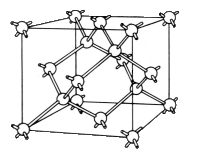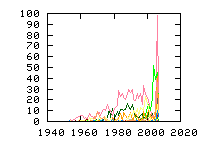« Previous
1
Next »
(7 hits, 1/1)
Showing
10, 25, 50, 100, 500, 1000, all papers per page.
Sort by:
last publication date,
older publication date,
last update date.
- 1. Appl. Phys. Lett. 90, 123502 (2007) , “Observation of negative bias stressing interface trapping centers in metal gate hafnium oxide field effect transistors using spin dependent recombination”,The authors combine metal oxide semiconductor (MOS) gated diode measurements and very sensitive electrically detected electron spin resonance measurements to detect and identify negative bias temperature instability (NBTI) generated defect centers in fully processed HfO2 pMOS field effect... (Read more)
- 2. Appl. Phys. Lett. 87, 204106 (2005) , “Direct observation of the structure of defect centers involved in the negative bias temperature instability”, J. P. Campbell and P. M. LenahanWe utilize a very sensitive electron paramagnetic resonance technique called spin-dependent recombination to observe and identify defect centers generated by modest negative bias and moderately elevated temperatures in fully processed p-channel metal-oxide-silicon field-effect transistors.... (Read more)
- 3. Microelectron. Reliability 45, 57 (2005) , “Characterization of interface defects related to negative-bias temperature instability SiON/Si<100> systems ”,Interface defects related to negative-bias temperature instability (NBTI) in an ultrathin plasma-nitrided SiON/ Si<100> system were characterized by using conductance–frequency measurements, electron-spin resonance measure- ments, and synchrotron radiation X-ray photoelectron spectroscopy. It was confirmed that NBTI is reduced by using D2-annealing instead of the usual H2-annealing. Interfacial Si dangling bonds (Pb1 and Pb0 centers) were detected in a sample subjected to negative-bias temperature stress (NBTS). Although we suggest that NBTS also generates non-Pb defects, it does not seem to generate nitrogen dangling bonds. These results show that NBTI of the plasma-nitrided SiON/Si system is predominantly due to Pb depassivation. Plasma nitridation was also found to increase the Pb1/Pb0 density ratio, modify the Pb1 defect structure, and increase the latent interface trap density by generating Si suboxides at the interface. These changes are likely to be the causes of NBTI in ultrathin plasma-nitrided SiON/Si systems. (Read more)
- 4. J. Appl. Phys. 95, 4096 (2004) , “Nitridation effects on Pb center structures at SiO2/Si(100) interfaces ”,Interfacial defect structures of NO-nitride oxide on Si(100) were characterized by electron spin resonance spectroscopy. We confirmed that the effective g values of the Pb1 center are affected by interfacial nitridation even at a small nitrogen concentration of 5 at. %, while those of the Pb0 center proved to be unchanged. We observed that the shifted Pb1 line appeared gradually with interfacial nitrogen concentration, which suggests that the nitrogen-induced modified structure substitutes for the original Pb1 structure. Angular variations of the shifted Pb1 lines were also significantly different from those of pure oxide. Based on our analysis, we attributed the g value shift of the Pb1 center to dangling bond tilting, caused by the displacement of nearest-neighbor Si atoms. (Read more)
- 5. Appl. Phys. Lett. 82, 3677-3679 (2003) , “Interface defects responsible for negative-bias temperature instability in plasma-nitrided SiON/Si(100) systems”, Shinji Fujieda, Yoshinao Miura, and Motofumi SaitohInterface defects generated by negative-bias temperature stress (NBTS) in an ultrathin plasma- nitrided SiON/Si(100) system were characterized by using D2 annealing, conductance-frequency measurements, and electron-spin resonance measurements. D2 annealing was shown to lower... (Read more)
- 6. Appl. Phys. Lett. 80, 1945-1947 (2002) , “Density of states of Pb1 Si/SiO2 interface trap centers”, J. P. Campbell and P. M. LenahanThe electronic properties of the (100) Si/SiO2 interfacial defect called Pb1 are quite controversial. We present electron spin resonance measurements that demonstrate: (1) that the Pb1 defects have levels in the silicon band gap, (2) that... (Read more)
- 7. Appl. Phys. Lett. 76, 3771-3773 (2000) , “Do Pb1 centers have levels in the Si band gap? Spin-dependent recombination study of the Pb1 "hyperfine spectrum"”, Tetsuya D. Mishima and Patrick M. LenahanThe electronic properties of the (001) Si/SiO2 Pb1 defect are the subject of considerable controversy. We present spin-dependent recombination results which indicate most strongly that the Pb1 centers have levels in the Si band gap. Our... (Read more)
« Previous
1
Next »
(7 hits, 1/1)
Showing
10, 25, 50, 100, 500, 1000, all papers per page.
Sort by:
last publication date,
older publication date,
last update date.
All papers (3399)
Updated at 2010-07-20 16:50:39
Updated at 2010-07-20 16:50:39
(view as: tree
,
cloud
)
| 1329 | untagged |
Materials
(111 tags)
Others(101 tags)
Technique
(46 tags)
Details
(591 tags)
Bond(35 tags)
Defect(interstitial)(18 tags)
Defect(vacancy)(15 tags)
Defect-type(19 tags)
Element(65 tags)
Energy(8 tags)
Isotope(56 tags)
Label(303 tags)
Sample(17 tags)
Spin(8 tags)
Symmetry(15 tags)

